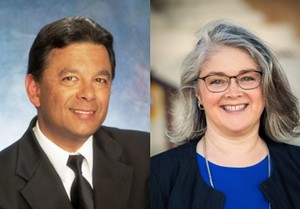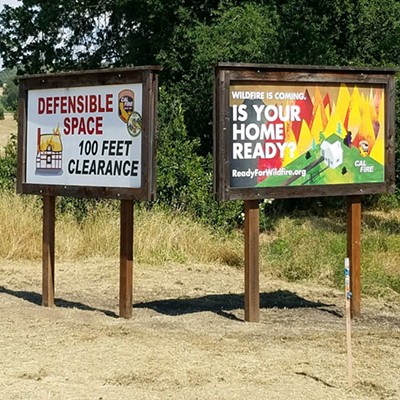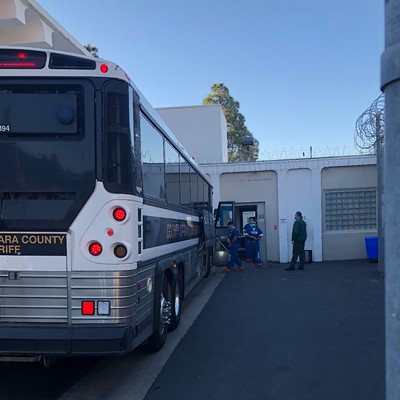The Lompoc mayoral race this year brings together familiar faces, with incumbent Mayor Jenelle Osborne running against 2nd District City Councilmember Victor Vega. The Sun spoke with the candidates to hear more about their campaign priorities and issues that will define the upcoming election and beyond.

Though Osborne is originally from Texas, the mayoral incumbent said she’s made Lompoc her “hometown in California.”
After initially getting involved with city politics as vice chair and chair of the city’s Economic Development Committee, Osborne first ran for an elected position in 2016, when she won a seat on the Lompoc City Council. Part way through her term, the mayorship was up for election in 2018—she ran and won.
“I’m doing it again because I still love this community, there’s still a lot of work that needs to be done,” Osborne said. “It hasn’t discouraged me that the past two years have been difficult.”
Vega, Osborne’s opponent, has served as a City Council member since first getting elected in 2014, then reelected in 2018. Outside of politics, Vega’s a real estate broker by trade. He was born and raised in the community.
“I’ve attended local schools, graduated from Lompoc High, and I’ve been home-grown ever since,” he said.
Vega’s campaign platform centers on economic development, he said.
“We need to repackage Lompoc so we know what we stand for,” he said. “What I’m trying to do is minimize missed opportunities that come to the city of Lompoc.”
For Vega, a big issue is making sure that Lompoc pays off its unfunded liability with the California Public Employee Retirement System (CalPERS), which sits at more than $90 million. Rising pension costs are crowding out budgets in cities throughout the state, including Lompoc, and the city’s 1 percent sales tax—which saw a victory with voters in the March primary—can help to pay it off. Vega supports this.
“It affects all the employees, present and past, that are pensioned, which is really important,” he said. “Without addressing the budgetary issue there, we can’t move forward at all. [The tax] is meant to support our public safety and address a repayment program for that unfunded liability, so we can move forward finally with a payment schedule for the next 15 years.”
But Osborne believes the council majority’s move toward what she called an “aggressive” payment plan might be the wrong one. She wishes the sales tax revenue could be used in other arenas, especially in the wake of the pandemic, to improve Lompoc residents’ quality of life.
“Had COVID not hit us, and had the economy not changed, and had we known that the 1 percent additional revenue would stay at $5 million, I wouldn’t have a problem with it,” she said. “But we have a different economy than when we first talked about this, and we don’t know how much our normal sales tax collection’s going to be.”
For this reason, Osborne believes that using the additional sales tax revenue to pay down the unfunded liability with CalPERS was “a bad idea in 2020.”
“As much as my opponent likes to talk about how this has saved the city $20 million, that’s not $20 million sitting in a savings account that I can now pivot and spend somewhere else,” she added.
Osborne’s other major campaign pillars include steering at-risk youth away from gang violence and fostering public safety. She emphasized a “proactive instead of just reactive” approach to crime.
“It’s identifying ways that we as a city can support other organizations and our own public safety department to engage with at-risk youths and provide opportunities to steer them away from gang life,” she said.
Vega spoke about the need to address nationwide conversations around policing in Lompoc.
“Absolutely we need to reform; it’s being called upon throughout the nation,” he said. “People feel that their needs are not being addressed. We may have to look at some oversight to make sure that the community feels safe.”
Highlight:
• The Central Coast Writers Conference, held from Sept. 24 to 26, is going virtual this year, with a few new scholarship opportunities available. The Voices of Color Scholarship, according to a press release, “is open to any persons of color interested in attending the conference and sharing their story.” Another available scholarship is the Teachers Writing Program, which is open to “Central Coast teachers navigating these unprecedented times.” The Teens Program Scholarship is available to youth age 11 to 18 years old attending public, private, or home schools in San Luis Obispo or Santa Barbara counties. Those interested in these scholarship opportunities can contact [email protected].
Staff Writer Malea Martin wrote this week’s Spotlight. Send story ideas to [email protected].
















